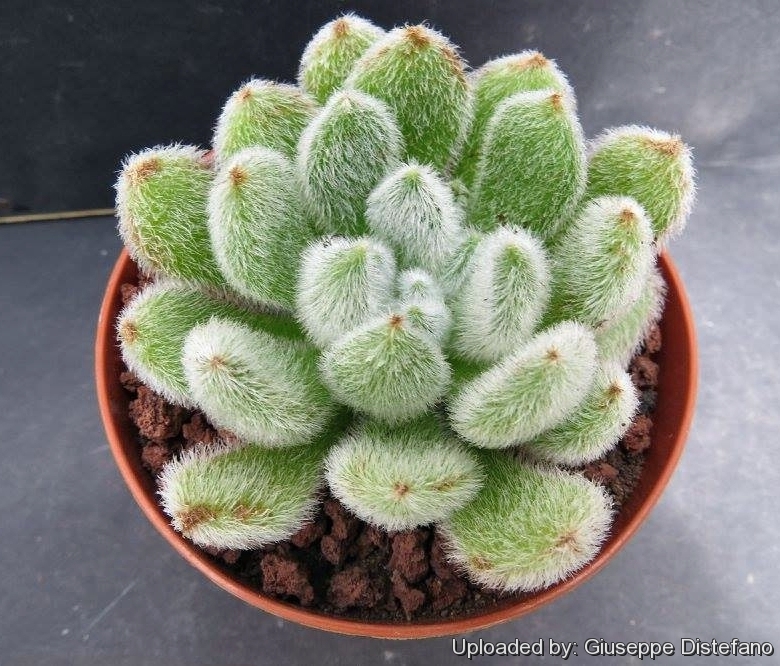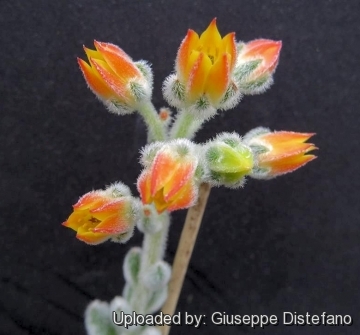
Echeveria cv. Bombicina Photo by: Giuseppe Distefano
Origin and Habitat: Garden origin (Nursery produced cultivar).
Synonyms:
Common Names include:
FRENCH (Français): Echeveria soyeuse
Description: Echeveria cv. Bombycina is a cross between Echeveria setosaSN|12352]]SN|12352]] and Echeveria pulvinataSN|12352]]SN|27450]]. This is one of the most commonly seen echeveria hybrid, which is usually seen without the 'x' on the label (indicating that it is a hybrid) and many collectors do not realise that this is not a true species. E. cv. 'Bombycina' is somewhat more furry and has tighter rosettes than its relative. This hybrid resembles Echeveria pilosa which is similar to Echeveria setosa, but its stem remains short, the rosette is more voluminous and denser and the leaves are larger and broader and very strongly hairy – giving it a less accentuated and more pleasant appearance. And above all the inflorescences are far less tall than those of E. setosa and E. pilosa, sometimes even extremely short, so that it looks as charming as Echeveria pulvinata which it resembles in shape, size, colour and texture of its radiant flowers.
Stem: Short, growing larger toward apex.
Rosettes: Usually single, geometrical, lager than Echeveria setosaSN|27450]]SN|12352]],
Leaves: Several, thick, obovate, much wider near apex than those of Echeveria setosaSN|12352]]SN|12352]] but less wide than those of Echeveria pulvinata, fresh green, and in the resting period coloured round the edges with deep pink and covered with thick long whitish hair.
Inflorescences: In the late summer it produces one to several arching cymes (inflorescences) often only 10 cm (or even less) in height, emerging from the upper part of the rosette, with fairly numerous bracts of medium size, alternate and also hairy.
Flowers: Normally less than 8, sometimes more than 10, well spaced, big, almost erect to nodding, urn-shaped, prominently pentagonal, brilliant orange and yellow. Pedicels 6 -15 mm. Calyx with 5 sepals, equal, appressed or a little opened, elongated, hairy, 10-12 mm long and 3-4 mm wide. Corolla with 5 petals, fairly large, thick, upright, not spreading, slightly opened, imbricate, strongly keeled, not recurved, apex acuminate, 15-20 mm long, generally entirely red, sometimes yellow orange or yellow and red outside, yellow inside. Stamen sterile. Carpel 5, slightly convex, yellow. Style green, tip purplish red. Plant generally sterile.
Bibliography: Major references and further lectures
1) African Succulent Plant Society "The Bulletin of the African Succulent Plant Society", Volumes 5-6 African Succulent Plant Society., 1970
2) Margaret J. Martin, Peter Richard Chapman "Succulents and their cultivation" Scribner, 1978
3) Cactus and Succulent Society of Great Britain "The Cactus and Succulent Journal of Great Britain", Volumi 32-35 1970
4) Pierre Gossot 22 Septembre 2008 "Echeveria soyeuse (Echeveria setosa Rose and Purpus x Echeveria pulvinata Rose)" International Crassulaceae Network <http://crassulaceae.net/echeveriamenu/45-hybrids/259-echeveria-bombycina-gossot-engl> Web. 12 Dec. 2015.
 Echeveria cv. Bombicina Photo by: Giuseppe Distefano
Echeveria cv. Bombicina Photo by: Giuseppe DistefanoSend a photo of this plant.The gallery now contains thousands of pictures, however it is possible to do even more. We are, of course, seeking photos of species not yet shown in the gallery but not only that, we are also looking for better pictures than those already present.
Read More... Cultivation and Propagation: It is essential in cultivation to use a very porous soil, with adequate drainage.
Exposition: Bright light is required to prevent "stretching" of Echeverias ("stretching" occurs when a moderately fast growing plant such as an Echeveria, is grown in dim light or over-fertilized, which causes overly lush growth that contributes to weak, pallid plants).
Watering: Water thoroughly when soil is dry to the touch.
Hardiness: Protect from frost.
Propagation: Quite easy from seed or from cuttings, the latter either from individual leaves or from offset rosettes.











